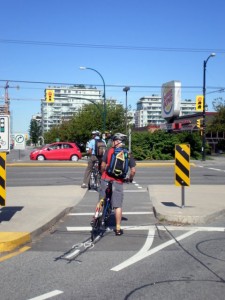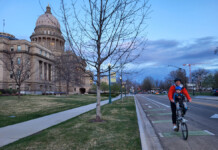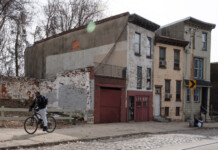
By Chad Mullins
Decades ago Vancouver made the decision to create a more livable urban environment through sustainable transportation. Since 1997 the Vancouver downtown population has grown 75%, while the greater Vancouver population has grown 18%. People are moving to downtown Vancouver because it is a community where people want to live.
The focus on active transportation became official City policy in 1997 when the City of Vancouver adopted a Transportation Plan with the “Policy Goals” of no increase in capacity for cars and a 20% reduction in downtown automobile traffic. A decision was made to prioritize transportation planning to accommodate traffic in the following order: first — pedestrians; second – bicycling; third – public transit; fourth – freight, and last – private autos. The objective was to shift mode share away from the automobile and focus on cycling as transportation. These decisions resulted in a major shift in transportation funding from road building to public transit and walking and biking.
Vancouver’s regional transportation planning, similar to other major Canadian cities, is structured to allow a unified approach to transportation planning. The Director of Transportation for Vancouver is also over TransLink, the government agency responsible for operating the public transit system. The Transportation Director with a staff of 300 also has authority over other forms of ground transportation in the region including regional roadways, traffic calming, greenways and bikeways, as well as parking, street activities and festivals, and traffic management. The City of Vancouver has a population of 700,000, and the region 2,300,000.
Under the Vancouver Bicycle Master Plan, TransLink has invested $50 million in bicycling infrastructure since 2000, and now has an annual bike capital spending program of $6 million with 3 full-time employees dedicated to bicycle planning. Part of the capital budget goes toward bicycle infrastructure cost sharing with the greater Vancouver municipalities.
The initial bicycle infrastructure expenditures were used to develop bikeways on local residential streets (bike boulevards). Stop signs were replaced with “traffic circles” (mini-roundabouts). Major investments were made to develop seaside linear parks with separated pedestrian and bicycle paths. New transit lines called “greenways” were built with parallel cycling and walking paths. These improvements were part of a strategic plan to encourage recreational riding, and to increase biking mode share by developing a bicycle culture.
More difficult decisions from a public perspective came later when travel lanes were replaced with bike lanes. The most controversial moves have been taking away travel lanes from the congested bridges, and replacing downtown travel lanes with downtown cycle tracks and protected bikeways.
Since 1997 the Vancouver downtown population has grown 75%, but the number of cars coming into the downtown has been reduced by 20%. In 2008 40% of all trips downtown were made walking, biking or using public transit. 25% of the Vancouver population now consider themselves regular cyclists. 12% of commuter trips downtown are made by cycling, although the commuter cycling mode share is only 2% for the entire region.
Vancouver has achieved recognition as a “walking city” with double the walking share of trips compared to Amsterdam and Copenhagen, which are considered the world’s biking capitals. Vancouver has the highest combined mode share for walking and biking trips in North America. A key public official said, “The two key ingredients for success have been building infrastructure and developing a cycling culture.”
Vancouver has adopted a plan to become the “Greenest City” in the world by 2020, and, therefore, updated its Climate Action Plan and 2040 Transportation Plan accordingly. The “Greenest City Action Plan” is based upon “Green Mobility.” The 2020 goal is to increase the percentage of downtown trips made by walking, biking and public transit to 50%. The 2030 goal is to increase that percentage to 66%. To achieve those results, Vancouver has an Active Transportation Implementation Strategy, an Active Transportation Policy Council and an Active Transportation Manager.
To increase the mode share split for alternative transportation, the Transportation Director re-defined the traffic engineering parameters. Traffic engineers were no longer designing streets primarily for traffic flow and increasing capacity for autos. Their new objectives were to make roads safer for all users and to encourage alternative transportation. Transportation spending was reallocated away from road building to transit and active transportation. Land-use and transportation planning were brought together. The land-use plan became a transportation plan and vice versa. With this integrated approach to transportation strategic planning, bicycling has become an integral part of the transportation network.
Vancouver’s urban planning philosophy and transportation planning incorporate the following strategies, concepts and ideas:
• Design cities and streets for people – not just for transportation
• Design streets for biking and walking which contributes to “place making” texture and culture; thereby moving away from the car culture
• Make “Transit corridors” into “Greenways” with parallel facilities for walking and biking. Do not build transportation corridors just for cars.
• Combine biking and walking with transit for longer trips. Analyze walking and biking access for improvements within a 600 meter radius of transit stations.
• Plan for “eco-density” to facilitate sustainability and promote walking and biking.
o Vancouver’s Climate Change Plan solutions call for reducing VMT, vehicle miles traveled.
o Density “done well” and completeness of destinations (mixed-uses) utilizes the “power of nearness” and facilitates short trips.
• “Make cycling easy, safe, comfortable, efficient and fun for people of all abilities and ages,” is Vancouver’s cycling goal.
• Prioritize routes and signals for bikes, pedestrians and transit — travel time is important. Make cycling the fastest mode of transportation for shorter trips.
• Add separated bike paths to substantially increase bicycle mode share. Note: pedestrian traffic on sidewalks and pedestrian paths also increases.
o “Protected bikeways” are the new standard for Vancouver biking infrastructure — no new “paint only” bike lanes.
o Separated bike paths are preferred, although buffered/protected bike lanes are an acceptable compromise.
o Survey showed 94% would prefer to bike separated from traffic. Motorists also preferred that bicyclists were separated from street traffic.
o Studies in Vancouver show separated bike lanes are a game changer — increasing the number of cyclists by 200% or more. The average percentage of women to men increased from 28% to 38% (20% increase in NYC), and the number of children riding tripled.
• Protect cyclists from right turning traffic: right turns on red are prohibited across bike paths.
• Emphasize cycling’s economic benefits:
o Cycling is the most cost effective way to increase transportation capacity and shift mode share.
o Biking is a major economic factor for tourism.
o Bike friendly streets and convenient bike parking benefit local merchants and businesses.
• Develop employee cycling promotion/coaching programs for government offices and employers.
• “Always build for the future – do not expect immediate ridership.”
Because all modes of transportation planning are combined under one agency, Vancouver has taken a unified approach to regional transportation planning. Through the integration of alternative modes of transportation and traffic demand management, Vancouver has been successful in creating a people friendly city and an efficient public transportation network that focuses on walking and cycling.
Vancouver’s Mayor Gregor Robertson summed it up when he said, “Cycling simply makes sense.”
Chad Mullins is chair of the Salt Lake County Bicycle Advisory Committee. See slcbac.org for more details.






